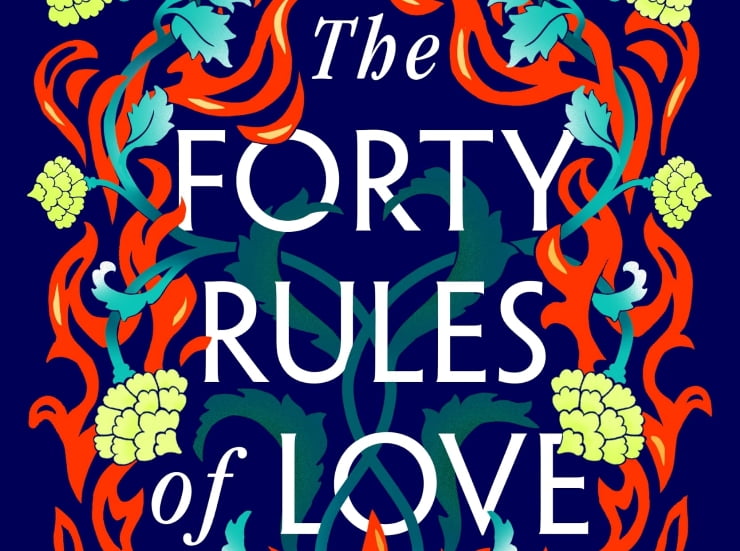Blog tour: The Forty Rules of Love by Elif Shafak

This post is part of a blog tour organised by Random Things Blog Tours. I received a free copy of the book in return for an honest review.
Originally published in 2010 and an international bestseller, The Forty Rules of Love is being republished on 3 July 2025 with a fresh jacket to tie in with the paperback release of Elif Shafak’s latest novel, There Are Rivers in the Sky.
‘Ella Rubinstein has a husband, three teenage children, and a pleasant home. Everything that should make her confident and fulfilled. Yet there is an emptiness at the heart of Ella’s life - an emptiness once filled by love.
‘So when Ella reads a manuscript about the thirteenth-century Sufi poet Rumi and his mentor Shams of Tabriz, and his forty rules of life and love, she is ready to look at her life anew.
‘Compelled to embrace change, Ella embarks on a journey to meet the mysterious author. It is a quest infused with Sufi mysticism and verse, taking Ella and us into a faraway world where faith and doubt are heartbreakingly explored.’

The Forty Rules of Love, by Elif Shafak, is a book within a book. In Northampton, Massachusetts in 2008, comfortable but unfulfilled housewife Ella Rubinstein secures a part-time job as a reader for a literary agency, where her first assignment is to critically evaluate Sweet Blasphemy, a manuscript by a mysterious European first-time author, A. Z. Zahara.
Set mainly in Konya, Anatolia in the 1240s, Sweet Blasphemy follows the intense friendship that quickly developed between the Islamic scholar and poet Rumi and the irreverent wandering dervish Shams of Tabriz, and the appalled reaction of certain members of Rumi’s family and wider community.
We know from the start that Shams is ultimately assassinated, but as he makes quite a few enemies over the course of the story, we have to wait to find out who was responsible, and what actually happened. Along the way, we also learn a lot about Shams’ personality and beliefs, including the titular rules, and hear from characters who have time for him, as well as those who don’t.
Captivated by Sweet Blasphemy, Ella starts to question her long-held belief that the all-consuming rush of romantic love must, by necessity, give way to stable companionship, practicality, and duty after marriage and children. She also starts a deep email correspondence with the author, Aziz. Will Ella finally admit to herself she hasn’t been happy for a long time, and put her own needs first for a change?
The Forty Rules of Love contains multitudes. As well as the book-within-a-book thing – which I always very much have time for! – it’s a thrilling whodunit with short chapters from multiple points of view (lots of ‘just one more, it’s only a couple of pages’), an historical novel, and an easy-to-digest short course on philosophy in the medieval Middle East (I was reminded of Sophie’s World, by Jostein Gaarder – if The Forty Rules of Love had been out and crossed my path when I was doing GCSE or A Level Religious Studies, I’d have probably gone wild for it).
As a character, Ella is… okay, once she starts questioning things. This is the one area where The Forty Rules of Love shows its age: it seems unlikely that the plight of a 39-year-old desperate housewife with three children in their mid/late teens, a generous suburban house, a pied-á-terre in Boston (two hours’ drive away), and a holiday home on Rhode Island, all paid for with a single salary (her husband is a dentist) would attract as much sympathy and/or strike as much of a chord among readers of a similar age now as it may have done previously. While I’m not sure the author intended Ella to be quite as objectionable as I found her initially, I did feel warmer towards her by the end.
On the flipside, I adored Shams, and think the years may have increased his appeal to readers. I read him as AuDHD and asexual, which I don’t think many people would have done in 2010.
To substantiate: Shams only obeys the rules that make sense to him – i.e., the forty he’s formulated; he doesn’t “get” social hierarchies; he’s often perceived as rude, when he’s actually just being direct, or asking questions out of curiosity or to prompt people to think; he gets distracted and bored easily, but can also talk to Rumi for hours on topics he’s passionate about; and he doesn’t show any interest in sex, even when Rumi marries him off in the hope of winning the townspeople’s acceptance (this lack of desire also helps us get around the nowadays awkward fact of the bride’s tender age).
I also appreciated how Shams and Rumi show a relationship doesn’t have to involve sex to be close and special – an idea some of the locals can’t get their heads around, adding to suspicion and disapproval of the pair. Friendships aren’t given enough credit in general, commonly being viewed as inferior to romantic/sexual relationships, yet the friendship at the centre of this story shows they can be just as, or even more intense, transformative, and important.
While my interest in religion comes from an intellectual/social sciences perspective (different viewpoints and practices, morality and ethics, how religion shapes people’s thoughts and behaviours individually and en masse, the influence of religion on society and the arts… just some of the reasons R.S. was one of my favourite subjects at school), with Shams, Shafak really sold Sufism to me!
With its emphasis on focussing on your own spiritual journey rather than judging and policing how well others adhere to religious tenets, meditating on and considering different interpretations of the Qur’an rather than taking its words at face value, overcoming the nafs (false ego), and working towards a higher state of being, Sufism doesn’t sound totally unlike Buddhism, which always appealed to me more than any other religion I was taught about.
That’s far from the only crossover between religions that becomes apparent in The Forty Rules of Love/Sweet Blasphemy, though. For one thing, thirteenth-centry Anatolia was a melting pot of ethnicities, nationalities, and religions; Rumi’s wife Kerra, for example, has converted to Islam from Christianity, and still finds comfort in Mother Mary, which Shams encourages.
Characters who feature in both the Qur’an and the Bible pop up from time to time. Befriending, respectively, a homeless leper, a drunk, and a sex worker seeking reform, and performing what look conspicuously like miracles, you can’t help but liken Shams to Jesus.
It’s therefore unsurprising that Shams makes so many enemies, from a religious instructor who doesn’t like being questioned; to a hypocritical guard who beats people for drunkenness yet frequents the brothel; to those who think he’s in league with Sheitan and practicing black magic; to members of Rumi’s family who don’t like how Shams has monopolised Rumi’s attention and besmirched their respectable reputation; and more besides. Even though I knew all along that Shams was going to die (as did he, thanks to his visions), I still felt the loss when he met his fate.
The Forty Rules of Love is a compulsive, kaleidoscopic, and highly engaging read.
